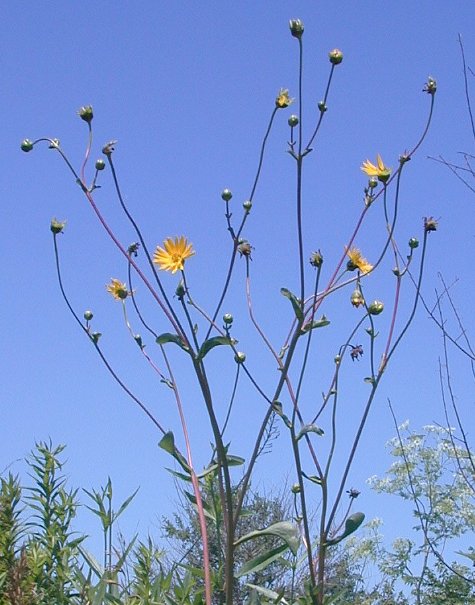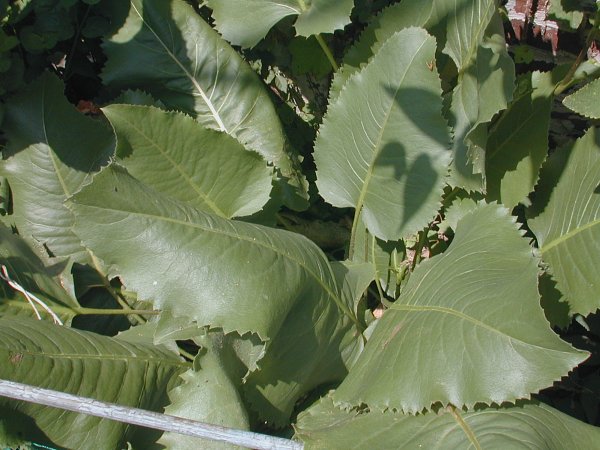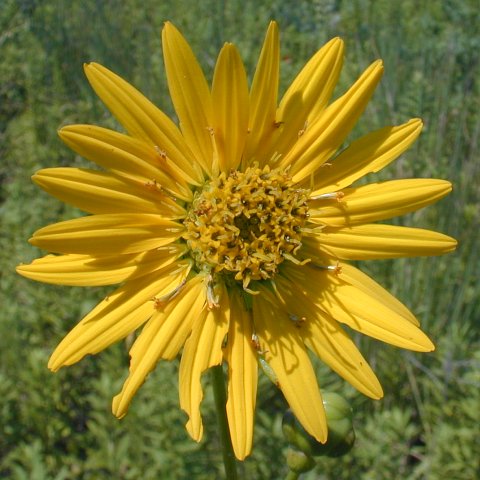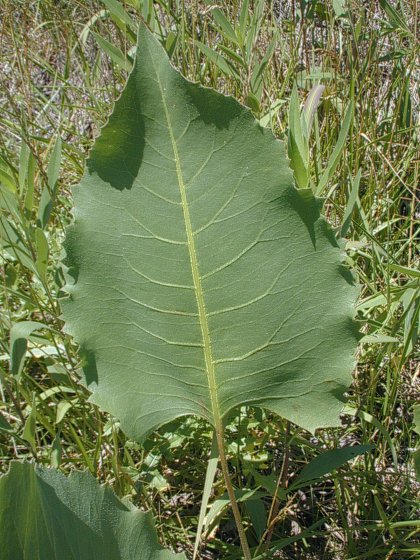Description: This plant has a vase-like rosette of large basal leaves that are spade-shaped (cordate). The basal leaves have a thick sandpapery texture, particularly on the underside, and they are up to 18" long and 12" wide. On young leaves, the upper surface is relatively hairless and shiny, while older leaves become dull and rough. The lower surface is light green and short-pubescent. The leaf margins are coarsely serrated or dentate. Leaf venation is pinnate. The petioles are about 6" long, rather narrow and wiry, and light green or yellowish brown. The overall appearance is similar to a rhubarb plant, except the petioles are more slender and the leaves are more stiff.

One or more naked flowering stalks develop from the base of the plant, ranging in height from 3' to 10' in height. These stalks are green or reddish purple, and largely hairless. The upper part of each stalk divides gracefully into a panicle of yellow flowerheads and spherical green buds. Each flowerhead is about 2–2½" across, consisting of 15-30 ray florets with rather pointed tips surrounding numerous disk florets. There is no noticeable floral scent. The blooming period usually occurs from late summer to early fall, and lasts about a month for an individual plant. Prairie Dock usually blooms later than other Silphium spp. It has a stout taproot that can penetrate the soil to about 12' deep, and may form offsets only a short distance away from the mother plant. The rather light, flattened achenes can be carried several feet by the wind; they are without tufts of hair.

Cultivation:
The preference is full sun, a deep loamy
soil, and moist to slightly dry conditions. Rocky or gravelly soil is
tolerated. Drought tolerance is very good. Prairie Dock is rather slow
to develop, but it is very reliable and nearly indestructible at
maturity.
Patches of brown may develop when the leaves are damaged by drought,
windstorms, or passing animals. It is a long-lived plant.
Range
& Habitat:
The native Prairie Dock occurs in most of Illinois,
except for a few counties in the south and NW (see Distribution
Map). It is a common plant. Habitats include moist to dry
black soil prairies, gravel prairies, shrub prairies, hill prairies,
savannas, seeps, limestone glades, and prairie remnants along roadsides
and railroads. The exceptional height of the flowering stalk is
probably useful in keeping the flowers above the taller grasses, such
as Andropogon gerardii (Big Bluestem). Recovery
from occasional wildfires is very good.

Faunal Associations: The composite flowers attract long-tongued bees primarily, including honeybees, bumblebees, and Miner bees. Other flower visitors include Halictine bees, bee flies, and the Ruby-Throated Hummingbird. Both the larvae and adults of the Silphium Beetle (Rynchites sp.) feed on the flowerheads and stems of this and other Silphium spp. The larvae of Antistrophus rufus and Antistrophus minor (Gall Wasp spp.) feed on the flowering stem of Prairie Dock, forming invisible galls. The larvae of these species attract the hyperparasitic wasp Eurytoma lutea, whose larvae feed on these gall-formers. The larvae of Mordellistena aethiops (Tumbling Flower Beetle sp.) also feed within the stem, while the adults may feed on the flowerheads. The oligolectic Iowana frisoni (Aphid sp.) sucks juices from the flowering stem. Goldfinches eat the seeds, and may help to disperse them. Large mammalian herbivores, such as cattle, readily eat the foliage and stems of Prairie Dock. However, the coarse sandpapery leaves of mature plants are not attractive to the Cottontail Rabbit, which prefers vegetation that is shorter and more tender.

Photographic
Location:
The photographs of the flowerhead close-up and basal leaf close-up were
taken at Meadowbrook Park
in Urbana, the photograph of the panicles of flowerheads was taken
along a railroad in Champaign, while the photograph of the basal leaves
was taken at Dave Monk's postage stamp prairie in the latter city. Both
Urbana and Champaign are in Illinois.
Comments:
This is a typical plant of mesic black soil prairies that competes
successfully with tall prairie grasses. It has an impressive and
unusual appearance, like something out of the Stone Age when Columbian
mastodons and other megafauna inhabited the prairies of North America.
Prairie Dock can be readily distinguished from other wildflowers by its
large and distinctive basal leaves on long petioles. They are cordate
in shape (spade-shaped) and their margins are coarsely toothed. In
addition, this plant produces one or more panicles of flowerheads on
long naked stalks that usually extend far above the surrounding plants.
These branching stalks have only a few leafy bracts.